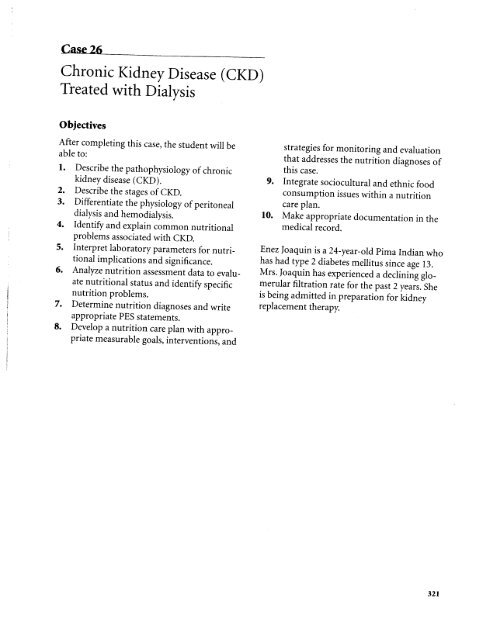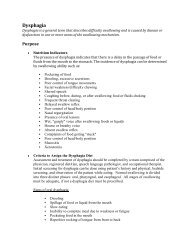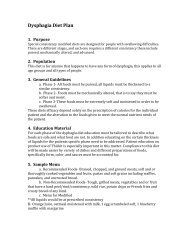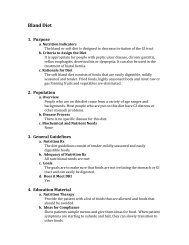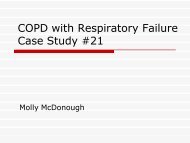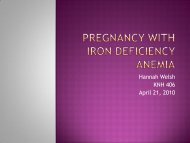Download File - Medical Nutrition Therapy Portfolio
Download File - Medical Nutrition Therapy Portfolio
Download File - Medical Nutrition Therapy Portfolio
Create successful ePaper yourself
Turn your PDF publications into a flip-book with our unique Google optimized e-Paper software.
Meghan Ames<br />
Mrs. Matuszak<br />
KNH 406<br />
April 3, 2010<br />
Chronic Kidney Disease Case Study #5<br />
I. Understanding the Disease and Pathophysiology<br />
1) Describe the physiological functions of the kidneys.<br />
The kidney has three functions. It is responsible for excreting water, minerals, and<br />
organic compounds, as well as removing nonessential solutes from the blood. A part of<br />
this maintenance includes regulation of acid-base and electrolyte balance. Finally, the<br />
kidney produces hormones such as erythropoietin and 1,25-dihydroxycholecalciferol.<br />
2) What disease/conditions can lead to chronic kidney disease (CKD)?<br />
Common causes of CKD include:<br />
diabetes<br />
hypertension<br />
glomerulonephritis<br />
hereditary cystic and congenital renal disease<br />
interstitial nephritis and pyelonephritis<br />
neoplasm/tumor<br />
3) Explain how type 2 diabetes mellitus can lead to CKD.<br />
Uncontrolled DM can result in extreme hypertension which can cause kidney damage.<br />
The thick blood and high concentrations of glucose can damage the glomeruli, resulting<br />
in albuminuria. Eventually glomeruli are destroyed and remaining nephrons are under<br />
further stress, which can eventually lead to chronic kidney disease.<br />
4) Outline the stages of CKD, including the distinguishing signs and symptoms.<br />
Stage 1 CKD is characterized by kidney damage with a normal or increased GFR (≥ 90<br />
mL/min/1.73m 2 ). Stage 2, 3, and 4 are characterized by mild (60-89 mL/min/1.73m 2 ),<br />
moderate (30-59 mL/min/1.73m 2 ), and sever (15-29 mL/min/1.73m 2 ), respectively,<br />
decreased in GFR. Stage 5 is full kidney failure, characterized by a GFR < 15<br />
mL/min/1.73m 2 .<br />
5) From your reading of Mrs. Joaquin’s history and physical, what signs and symptoms did<br />
she have?
2<br />
Mrs. Joaquin is at risk for renal problems because of her DM. Documented signs of<br />
decreasing renal function include declining GFR, increasing creatinine and urea<br />
concentrations, elevated serum phosphate, and normochromic, normocytc anemia. In<br />
addition her weight gain, edema, and decreased urine output are signs of fluid imbalance<br />
which may be related to renal trouble.<br />
6) What are the treatment options for Stage 5 CKD?<br />
Stage 5 CKD is treated with renal replacement therapy (hemodialysis or peritoneal<br />
dialysis) and nutrition therapy. Goals of nutrition therapy are to meet nutritional<br />
reequriements, prevent malnutrition, minize uremia and associated CKD complications,<br />
and maintain blood pressure and fluid status. Renal transplantation is the ideal treatment.<br />
7) Describe the differences between hemodialysis and peritoneal dialysis.<br />
In hemodialysis, the dialyzer is manmade and the filtration takes place outside of the<br />
patient’s body. In hemodialysis, the circulatory system is accessed via an arteriovenous<br />
fistula, and blood travels to the external dialyzer membrane. Peritoneal dialysis utilized<br />
the patient’s peritoneal cavity, and blood is accessed while it remains in the vessels.<br />
II. Understanding the <strong>Nutrition</strong> <strong>Therapy</strong><br />
8) Explain the reasons of the following components of Mrs. Joaquin’s medical nutrition<br />
therapy:<br />
<strong>Nutrition</strong> <strong>Therapy</strong><br />
Rationale<br />
35 kcal/kg Provide adequate energy to prevent malnutrition<br />
1.2 g protein/kg Ensure neutral or positive nitrogen balance and<br />
provide adequate amino acids<br />
2 g Na Decrease Na intake due to decreased Na excretion<br />
1,000 mL fluid + urine output Maintain fluid balance<br />
III. <strong>Nutrition</strong> Assessment<br />
A. Evaluation of Weight/Body Composition<br />
9) Calculate and interpret Mrs. Joaquin’s BMI. How does edema affect your interpretation?<br />
height = 5’ = 1.5 m<br />
weight = 170 # = 77.3 kg UBW = 73.3 kg<br />
BMI = 77.3 kg / 1.5 2 m = 34.4 BMI considering UBW = 73.3 kg / 1.5 2 m = 32.6<br />
Mrs. J.’s BMI classifies her as obese. Her current weight suggests that she is obese (BMI<br />
= 34.4), but considering her reported weight gain (likely resulting from edema) she is still<br />
considered obese (BMI = 32.6)
3<br />
10) What is edema-free weight? The following equation can be used to calculate the edemafree<br />
adjusted body weight (aBW ef ):<br />
aBW ef = BW ef + [(SBW- BW ef ) x 0.25]<br />
where BW ef is the actual edema-free body weight and SBW is the standard body weight<br />
as determined from the NHANES II data.<br />
Calculate Mrs. Joaquin’s edema-free weight. Is this the same as dry weight?<br />
Edema-free weight is an individual’s standard body weight that is not impacted by any<br />
symptoms of edema.<br />
NHANES SBW = 50 kg<br />
BW ef = actual edema-free body weight = 73.3 kg<br />
aBW ef = edema-free adjusted body weight = 73.3 kg + [(50-73.3) x 0.25] = 67.5 kg<br />
Mrs. J.’s edema-free weight is slightly lower than her dry weight (73.3 kg) because dry<br />
weight is her weight after just one round of dialysis, which does not rid the body of all<br />
the excess water it is holding. Mrs. J.’s edema-free adjusted body weight (67.5 kg)<br />
suggests that she can still lose more water weight.<br />
B. Calculation of Nutrient Requirements<br />
11) What are the energy requirements for CKD?<br />
30-35 cal/kg for over 60 years and 35 kcal/kg for under 60 years<br />
12) Calculate what Mrs. Joaquin’s energy needs will be once she beings hemodialysis.<br />
kcal = 35 kcal/kg = 35 kcal x 67.5 kg = 2362.5 ≈ 2,350<br />
13) What are Mrs. Joaquin’s protein requirements when she begins hemodialysis?<br />
g. protein = 1.2 g/kg = 1.2 g x 67.5 kg = 81 g protein<br />
14) What is the rationale? How would these change if she were on peritoneal dialysis?<br />
Energy needs of those in hemodialysis are similar to or slightly higher than those of<br />
healthy individuals. It is recommended that patients older than 60 years old receive 30-35<br />
kcal/kg and those younger than 60 years old receive 30 kcal/kg. Individuals receive<br />
peritoneal dialysis have similar energy needs and must only be sure to consider<br />
kilocalories provided by dialysate.<br />
Protein needs for individuals on dialysis are slightly higher than healthy individuals<br />
because the kidney replacement therapy removes additional proteins from the blood (≈<br />
10-12 g free amino acids and 5-15 g albumin daily). In addition, protein needs are higher<br />
due to inflammation, infection, altered albumin turnover, and metabolic acidosis. Patients<br />
on both hemodialysis and peritoneal dialysis treatment need 1.2 g/kg of protein daily with
4<br />
at least 50% coming from sources with a high biological value. The only special<br />
consideration for peritoneal dialysis is that needs increase during episodes of peritonitis.<br />
C. Intake Domain<br />
15) Are there any potential benefits of using different types of protein, such as plant protein<br />
rather than animal protein, in the diet for a patient with CKD? Explain.<br />
At least 50% of protein intake should be from sources with high bioavailability.<br />
Complete proteins are more bioavailable than incomplete proteins, and thus animal<br />
sources are sometimes a better choice. Benefits of one protein source must also be<br />
weighed with the other nutrients, such as fats, vitamins, and minerals, that are also<br />
included in that food choice.<br />
16) Mrs. Joaquin has a PO 4 restriction. Why?<br />
A decreasing GFR can result in hyperphosphatemia. In order to prevent this, CKD<br />
patients must decrease dietary intakes of phosphorus.<br />
17) What foods have the highest level of phosphorus?<br />
Foods high in phosphorus include beer, cocoa, colas, cheese, milk, liver, shellfish, peas,<br />
beans, and whole grain products.<br />
18) Mrs. Joaquin tells you that one of her friends can drink only certain amounts of liquids<br />
and wants to know if that is the case for her. What foods are considered to be fluids?<br />
What recommendations can you make for Mrs. Joaquin?<br />
Foods that are considered fluids include soups, popsicles, sherbet, ice cream, yogurt,<br />
custard, and gelatin. Mrs. J. is still holding excess fluids that need to be removed. Until<br />
her weight returns to normal, she should restrict fluid intake. After usual body weight is<br />
met, Mrs. J. should alter fluid intake to balance with fluid output.<br />
19) If a patient must follow a fluid restriction, what can be done to help reduce his or her<br />
thirst?<br />
Intakes high in sodium increase thirst, and thus high sodium foods should be avoided.<br />
Additional tips include maintaining healthy oral hygiene, use lip balm, consume frozen<br />
fruits, and drink form small glasses/cups.<br />
20) Identify nutrition problems within the intake domain using the appropriate diagnostic<br />
term.<br />
Excessive phosphorus intake (NI-55.2) RT CKD and reduced GFR AEB serum PO 4 level<br />
of 9.5 mg/dL.<br />
Excessive fluid intake (NI-3.2) RT CKD and reduced GFR AEB edema and weight gain.
5<br />
Limited adherence to nutrition-related recommendations RT pt.’s interpretation of<br />
recommendations to be too difficult AEB pt. self-report, diet hx, and noncompliance.<br />
D. Clinical Domain<br />
21) Several biochemical indices are used to diagnose chronic kidney disease. One is<br />
glomerular filtration rate (GFR). What does GFR measure?<br />
Glomerular filtration rate is a measure of the filtration ability of the glomerulus, and can<br />
be used as an index of kidney function. Normal GFR values fall around 125 mL/min.<br />
22) What test is usually done to estimate glomerular filtration rate?<br />
The plasma creatinine is usually measured and applied to the appropriate equation,<br />
considering age, weight (edema-free), gender, and race.<br />
23) Mrs. Joaquin’s GFR is 28 mL/min. What does this tell you about her kidney function?<br />
Mrs. Joaquin is in Stage 4 CKD (GFR between 15 and 29 mL/min/1.73m 2 ) suggesting<br />
that she has kidney damage resulting in a serious decrease in GFR. At this point, Mrs. J.<br />
is approaching kidney failure and kidney replacement therapy is necessary.<br />
24) Evaluate Mrs. Joaquin’s chemistry report. What labs support the diagnosis of Stage 4<br />
CKD?<br />
Mrs. J’s BUN is 59 mg/dL, which is way above the normal range of 8-18 mg/dL<br />
suggesting that the kidneys are failing to remove nitrogenous waste from the blood.<br />
Potassium (5.8 mEq/L) and phosphate (9.5 mg/dL) levels are also higher than the normal<br />
ranges of 3.5-5.5 mEq/L and 2.3-4.7 mg/dL, respectively. Calcium (8.2 mg/dL) levels are<br />
slightly low and total cholesterol (220 mg/dL) and triglycerides (200 mg/dL) are high.<br />
25) Examine the patient care summary sheet for hospital day 2. What was Mrs. Joaquin’s<br />
weight postdialysis? Why did it change?<br />
Mrs. J’s postdialysis weight is 165 lb., showing a 5 lb. loss since before dialysis. This is<br />
due to a loss of fluid resulting from the dialysis.<br />
26) Which of Mrs. Joaquin’s other symptoms would you expect to begin to improve?<br />
As Mrs. J. continues dialysis, her weight should return to normal with a reduction of<br />
edema and blood pressure. Her appetite should return and her nausea and vomiting<br />
should dissipate.<br />
27) Explain why the following medications were prescribed by completing the table.<br />
Medication Indications/Mechanism <strong>Nutrition</strong>al Concerns<br />
Vasotec ACE inhibitor; treat HTN None<br />
Erythropoietin Increase Hb concentrations Possible iron deficiency
6<br />
Vitamin/mineral supplement Replenish vitamins/minerals<br />
lost in HD<br />
Possible toxicity if<br />
overconsumed<br />
Calcitriol Prevent hypocalcemia Consume with low<br />
phosphate diet<br />
Glucophage* Manage blood sugar None<br />
Sodium bicarbonate* Neutralize stomach acid Consume with low-Na diet<br />
Phos Lo* Reduce phos. levels Should not be taken if<br />
hypercalemia<br />
*should not be taken if pt. has kidney problems<br />
Adapted from www.drugs.com and www.nlm.nih.gov<br />
28) Identify nutrition problems within the clinical domain using the appropriate diagnostic<br />
term.<br />
Excessive fat intake (NI-51.2) RT pt. food choices AEB dyslipidemia.<br />
Excessive potassium and phosphorus intake RT CKD and reduced GFR AEB serum<br />
potassium level of 5.8 mEq/L and PO 4 level of 9.5 mg/dL.<br />
E. Behavioral-Environmental Domain<br />
29) What health problems have been identified in the Pima Indians through epidemiological<br />
data?<br />
Studies suggest that Pima Indians have over 20 times the rate of new cases of kidney<br />
failure and that over 90 percent of these cases can be attributed to diabetes (Harris, n.d.).<br />
30) Explain what is meant by the “thrifty gene” theory.<br />
The “thrifty gene theory” attempts to explain a genetic predisposition to diabetes. The<br />
theory suggests that people living in environments with frequent and regular stretches of<br />
famine adapted genetically to store food and energy more efficiently. When descendents<br />
of these individuals are placed in environments where food security is not a concern, their<br />
bodies still react as if famine were a reality, and can more easily lead to obesity and DM<br />
(Pyhtila, 2007).<br />
31) How does nephropathy affect Pima Indians?<br />
Diabetic nephropathy is a leading cause of renal disease and is prominent in the Pima<br />
Indian communities. According to Soman (2009), diabetic nephropathy is responsible for<br />
30-40% of all end-stage renal disease cases in the United States. Additionally,<br />
nephropathy is relatively high in Pima Indians, seen at about 50% of Pima Indians by the<br />
age of 20 (Soman, 2009).<br />
IV. <strong>Nutrition</strong> Diagnosis<br />
32) Choose two high-priority nutritional problems and complete a PES statement for each.<br />
Excessive fluid intake (NI-3.2) RT CKD and reduced GFR AEB edema and weight gain.
7<br />
Excessive potassium and phosphorus intake RT CKD and reduced GFR AEB serum<br />
potassium level of 5.8 mEq/L and PO 4 level of 9.5 mg/dL.<br />
V. <strong>Nutrition</strong>al Intervention<br />
33) For each PES statement, establish an ideal goal (based on the signs and symptoms) and<br />
appropriate intervention (based on the etiology).<br />
Reduce weight until actual weight reaches adjusted edema free body weight by<br />
consuming fluids not to exceed 1L/day plus daily urine output.<br />
Reduce serum potassium and phosphorus levels WNL by selecting foods that are low in<br />
phosphorus and potassium.<br />
34) When Mrs. Joaquin begins dialysis, energy and protein recommendations will increase.<br />
Explain why.<br />
Dialysis results in increased loss of protein. In addition protein and energy needs are<br />
higher in individuals with CKD due to inflammation, infection, altered albumin turnover,<br />
and metabolic acidosis.<br />
35) Why is it recommended for patients to have at least 50% of their protein from sources<br />
that have high biological value?<br />
Digestion of proteins is an additional stress on the kidneys and selecting more<br />
bioavailable protein sources can allow for decreased production of nitrogen waste and<br />
alleviate some of the stress on the kidneys.<br />
36) The MD ordered daily use of a multivitamin/mineral supplement containing B-complex,<br />
but not fat-soluble vitamins. Why are these restrictions specified?<br />
Loss of water soluble vitamins is a concern for dialysis patients due to the excess fluid<br />
removal. The MD ordered supplementation of the water-soluble vitamins to replace the<br />
vitamins lost in dialysis. It is not necessary to supplement fat-soluble vitamins because<br />
they are no impacted by kidney replacement therapy.<br />
37) What resources would you use to teach Mrs. Joaquin about her diet?<br />
I would provide Mrs. J. with lists of foods to choose and avoid as well as recipes and<br />
menus she can follow. Additionally, I could put together a tracking chart so that Mrs. J.<br />
can be knowledgeable of how much fluid and electrolytes she takes in daily.
HS<br />
Snack<br />
Dinner<br />
Lunch<br />
Breakfast<br />
8<br />
38) Using Mrs. Joaquin’s typical intake and the prescribed diet, write a sample menu. Make<br />
sure you can justify your changes and that it is consistent with her nutrition prescription.<br />
Diet PTA<br />
Sample Menu<br />
Cold cereal (3/4 c unsweetened) Select from refined grains<br />
Bread (2 slices) or fried potatoes (1 med Baked potatoes<br />
potato)<br />
1 fried egg (occasionally) 1 fried egg<br />
Bologna sandwich (2 slices white bread, Turkey sandwich (2 slices white<br />
2 slices bologna, mustard)<br />
bread, 2 slices turkey, mustard)<br />
Potato chips (1 oz)<br />
Pasta salad<br />
1 can coke Apple juice<br />
Chopped meat (3 oz beef)<br />
3 oz. beef<br />
Fried potatoes<br />
Crackers (6 saltines) and peanut butter<br />
(2 T)<br />
Broccoli<br />
6 saltines and 2 T peanut butter<br />
39) Using the renal exchange list, plan a 1-day diet that complies with your diet order.<br />
Provide a nutrient analysis to assure consistency with all components of the prescription.<br />
Rx: 2,300 kcal; 80 g protein; 2-3 g K; 2-3 g Na<br />
Food Na (mg) K (mg) Phos (mg) Protein (g) Kcal<br />
Breakfast<br />
4 oz. milk 60 185 110 4 75<br />
2 egg 120 124 170 12 155<br />
2 slices 270 60 50 4 130<br />
white toast<br />
4 T jelly 10 24 2 0 100<br />
Snack<br />
4 graham 170 40 30 2 120<br />
crackers<br />
3 T peanut 300 430 240 16 380<br />
butter<br />
Lunch<br />
3 oz. turkey 45 240 180 25 130<br />
breast<br />
2 slices 270 60 50 4 130<br />
white bread<br />
1 T. mayo 80 5 4 0.2 100<br />
1 c.<br />
strawberries<br />
1 240 27 1 40
9<br />
8 oz. iced 7 88 2 0 2<br />
tea<br />
Snack<br />
Carrots 25 230 30 0.7 30<br />
Bell pepper 1 100 12 0.5 15<br />
Dinner<br />
Portobello 6 518 140 4 36<br />
mushroom<br />
Broccoli 24 280 60 2.6 25<br />
White rice 2 55 70 4 200<br />
Biscuit 530 115 220 3.2 180<br />
White wine 5 80 15 0.1 70<br />
Ice cream 51 0 0 3 120<br />
Total 1.9 g 2.85 g 1.4 g 86 g 2,040<br />
40) Write an initial medical record note for your consultation with Mrs. Joaquin.<br />
A: 24 y/o female, dx with stage 4 CKD<br />
current weight = 77 kg, UBW = 73 kg, current BMI = 34.4<br />
D: Excessive fluid intake (NI-3.2) RT CKD and reduced GFR AEB edema and weight<br />
gain.<br />
Excessive potassium and phosphorus intake RT CKD and reduced GFR AEB serum<br />
potassium level of 5.8 mEq/L and PO 4 level of 9.5 mg/dL.<br />
I: Reduce weight until actual weight reaches adjusted edema free body weight by<br />
consuming fluids not to exceed 1L/day plus daily urine output.<br />
Reduce serum potassium and phosphorus levels WNL by selecting foods that are low in<br />
phosphorus and potassium.<br />
M/E: Continue to monitor pts. labs paying careful attention to BUN, K+, PO 4 , Na.<br />
Evaluate pts. dietary intake to ensure compliance with diet rx.
10<br />
References<br />
American Association of Kidney Patients. (n.d.). AAKP nutrition counter. Retrieved April 11,<br />
2010, from, http://www.aakp.org/brochures/nutrition-counter/nutrition-counter/#T<br />
Harris, M. (n.d.). Kidney disease. Retrieved April 8, 2010, from,<br />
http://diabetes.niddk.nih.gov/dm/pubs/pima/kiddis/kiddis.htm<br />
Nelms, M., Sucher, K., & Long, S. (2007). <strong>Nutrition</strong> and pathophysiology. Belmont, CA:<br />
Wadsworth.<br />
Pyhila, H. (2007, April). Genome education. Retrieved April 8, 2010, from,<br />
http://www.genomicseducation.ca/informationArticles/health/thrifty_gene.asp<br />
Soman, S. S. (2009, November 19). Diabetic nephropathy. Retrieved April 11, 2010, from,<br />
http://emedicine.medscape.com/article/238946-overview


